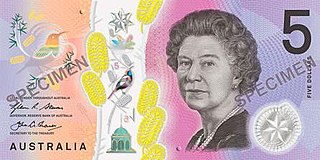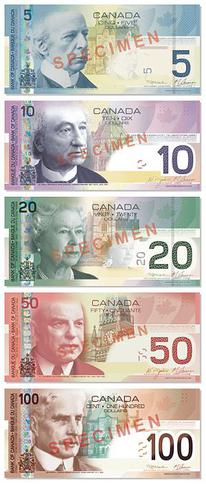The Kwacha is the currency of Zambia. It is subdivided into 100 Ngwee.

The United States five-dollar bill ($5) is a denomination of United States currency. The current $5 bill features U.S. president Abraham Lincoln and the Great Seal of the United States on the front and the Lincoln Memorial on the back. All $5 bills issued today are Federal Reserve Notes. As of December 2018, the average life of a $5 bill in circulation is 4.7 years before it is replaced due to wear. Approximately 6% of all paper currency produced by the U.S. Treasury's Bureau of Engraving and Printing in 2009 were $5 bills.

The United States ten-dollar bill ($10) is a denomination of U.S. currency. The obverse of the bill features the portrait of Alexander Hamilton, who served as the first U.S. Secretary of the Treasury, two renditions of the torch of the Statue of Liberty, and the words "We the People" from the original engrossed preamble of the United States Constitution. The reverse features the U.S. Treasury Building. All $10 bills issued today are Federal Reserve Notes.

The United States fifty-dollar bill ($50) is a denomination of United States currency. The 18th U.S. president (1869-1877), Ulysses S. Grant, is featured on the obverse, while the U.S. Capitol is featured on the reverse. All current-issue $50 bills are Federal Reserve Notes.

The United States one-hundred-dollar bill ($100) is a denomination of United States currency. The first United States Note with this value was issued in 1862 and the Federal Reserve Note version was first produced in 1914. Inventor and U.S. Founding Father Benjamin Franklin has been featured on the obverse of the bill since 1914, which now also contains stylized images of the Declaration of Independence, a quill pen, the Syng inkwell, and the Liberty Bell. The reverse depicts Independence Hall in Philadelphia, which it has featured since 1928.

The Portrait Series of currency notes is the fourth and current set of notes to be issued for circulation in Singapore. It was first introduced on 9 September 1999 by the Board of Commissioners of Currency, Singapore (BCCS), whose role was since taken over by the Monetary Authority of Singapore (MAS) post-merger.

Banknotes of the Canadian dollar are the banknotes or bills of Canada, denominated in Canadian dollars. Currently, they are issued in $5, $10, $20, $50, and $100 denominations. All current notes are issued by the Bank of Canada, which released its first series of notes in 1935. The Bank of Canada has contracted the Canadian Bank Note Company to produce the Canadian notes since then. The current series of polymer banknotes were introduced into circulation between November 2011 and November 2013. Banknotes issued in Canada can be viewed at the Bank of Canada Museum in Ottawa.

The Australian five-dollar note was first issued on 29 May 1967, fifteen months after the currency was changed from the pound to the dollar on 14 February 1966. It was a new denomination with mauve colouration – the pre-decimal system had no denomination with a value of £21⁄2. The first polymer version of the note was introduced on 7 July 1992. A major design update was issued on 1 September 2016, with a minor update to the signatures in 2019.
The fifth series of the renminbi is the current coin and banknote series of the Chinese currency, the renminbi. They were progressively introduced since 1999 and consist of ¥0.1, ¥0.5, and ¥1 coins, and ¥1, ¥5, ¥10, ¥20, ¥50, ¥100 notes. The ¥20 banknote is a new denomination, and was added in this series. All banknotes in this series feature a portrait of Chinese Communist Party chairman Mao Zedong by artist Liu Wenxi. Therefore, this series of banknotes is also known as "Grandpa Mao" among the people.

The Bank of England, which is now the central bank of the United Kingdom, British Crown Dependencies and British Overseas Territories, has issued banknotes since 1694. In 1921 the Bank of England gained a legal monopoly on the issue of banknotes in England and Wales, a process that started with the Bank Charter Act of 1844 when the ability of other banks to issue notes was restricted.

The 1935 Canadian banknote series is the first series of banknotes of the Canadian dollar issued by the Bank of Canada. They were first circulated on 11 March 1935, the same day that the Bank of Canada officially started operating. Two sets of banknotes were printed for each denomination, one in French for Quebec, and one in English for the rest of Canada. This is the only series issued by the Bank of Canada with dual unilingual banknotes. This series was followed by the 1937 Canadian banknote series.
The 1937 Canadian banknote series is the second series of banknotes of the Canadian dollar issued by the Bank of Canada. The banknotes were issued into circulation on 19 July 1937, at which time the Bank of Canada began gradually removing banknotes from the 1935 series from circulation. The $1000 banknote was issued several years later, as it was primarily used by chartered banks, which had a sufficient supply of the 1935 Series $1000 banknote.

Canadian Landscape is the third series of banknotes of the Canadian dollar issued by the Bank of Canada, first circulated in 1954. The banknotes were designed in 1952 following the accession of Elizabeth II to the throne after the death of her father George VI. The banknote designs differed significantly from the preceding 1937 Series banknotes, though the denomination colours and bilingual printing were retained. This series was followed by the 1969 Scenes of Canada series.
Scenes of Canada is the fourth series of banknotes of the Canadian dollar issued by the Bank of Canada. It was first circulated in 1970 to succeed the 1954 Canadian Landscape series and was followed by the 1986 Birds of Canada banknote series. This was the last series to feature a $1 bill, which was replaced by a $1 coin known as the loonie in 1987, although both the $1 bill and the loonie were produced concurrently for 21 months, from June 1987 to April 1989.

Canadian Journey is the sixth series of banknotes of the Canadian dollar designed and circulated by the Bank of Canada. It succeeded the 1986 Birds of Canada banknote series. The first banknote of the Canadian Journey series issued into circulation was the $10 bill on 17 January 2001, and the last to be issued was the $50 bill on 17 November 2004. The series was succeeded by the 2011 Frontier Series, the banknotes of which were first issued into circulation from 2011 to 2013.
The fifth series of the new Taiwan dollar banknotes is the current and latest series to be issued for circulation in the Republic of China (Taiwan). It was first introduced by the Central Bank of the Republic of China (Taiwan) on 3 July 2000.

The Philippine two hundred-peso note is a denomination of Philippine currency. President Diosdado Macapagal is currently featured on the front side of the note, and since 2017, President Gloria Macapagal Arroyo's inauguration as the 14th President of the Philippines is on the lower-left side on the note just in front of the scene of the Declaration of Philippine Independence, and the scene of the opening of the Malolos Congress is also present on the obverse side of the note. From 2010 to 2017, the Aguinaldo Shrine and the Barasoain Church were featured on the front side of the note. The Chocolate Hills and the Philippine tarsier is featured on the reverse side. Currently, it is the rarest banknote circulating in the country, and thus is seen more as a novelty than legal tender.

The Philippine five hundred-peso note (₱500) is a denomination of Philippine currency. Senator Benigno Aquino Jr. and his wife, President Corazon Aquino are currently featured on the front side of the note, while the Puerto Princesa Subterranean River National Park and the blue-naped parrot are featured on the reverse side.

The Frontier series is the seventh series of banknotes of the Canadian dollar released by the Bank of Canada, first circulated in 2011. The polymer banknotes were designed for increased durability and to incorporate more security features over the preceding 2001 Canadian Journey series. The notes feature images that focus on historic Canadian achievements and innovation. Printed on polymer, the 2011 Frontier series was the first series issued by the Bank of Canada printed on a material other than paper. The 2011 Frontier series was followed by the 2018 series.

The United States two-dollar bill ($2) is a current denomination of United States currency. A portrait of Thomas Jefferson, the third president of the United States (1801–1809), is featured on the obverse of the note. The reverse features an engraving of John Trumbull's painting Declaration of Independence.



























